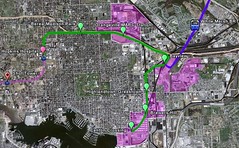Advocacy and institutional change
Sometimes people ask me (or write) about my advocacy or what I do, and they can be very derisive. Auguring and/or spurring on change or program improvement isn't easy, and because so many people are the do-ers and implementers, no one person can or should take credit. But those of us who are involved in things can see the incremental changes that occur. Plus, over time, if you're decent at what you do, your base of influence and network continues to grow, and you have more impact.
People that know me have seen me draw what I call the issue-advocacy continuum, which is pretty simple. It's a straight line with nodes at either end, and a bunch of widely scattered dots--representing different issue points. I stake out the position closer to the ideal (the right endpoint), knowing it can't likely be achieved, but knowing that there will be overall more movement in the end towards the ideal than if one had compromised or wimped out on the low change side of the continuum.
I mention this in the context of transit system planning in Baltimore. The B'more Mobile citizens group is having some impact on the current Baltimore Regional Transportation Plan. And the Baltimore Innerspace blog continues to plug away with some excellent suggestions and ideas for extending the subway system east, and beginning the process of connecting under- and un- connected transit modes. See "Bayview" from Baltimore Innerspace.

Image of a Baltimore subway extension (Green line) connecting to MARC and to BRT. Image by Gerald Neilly, Baltimore Innerspace.
Labels: civic engagement, land use planning, protest, transportation planning



0 Comments:
Post a Comment
<< Home